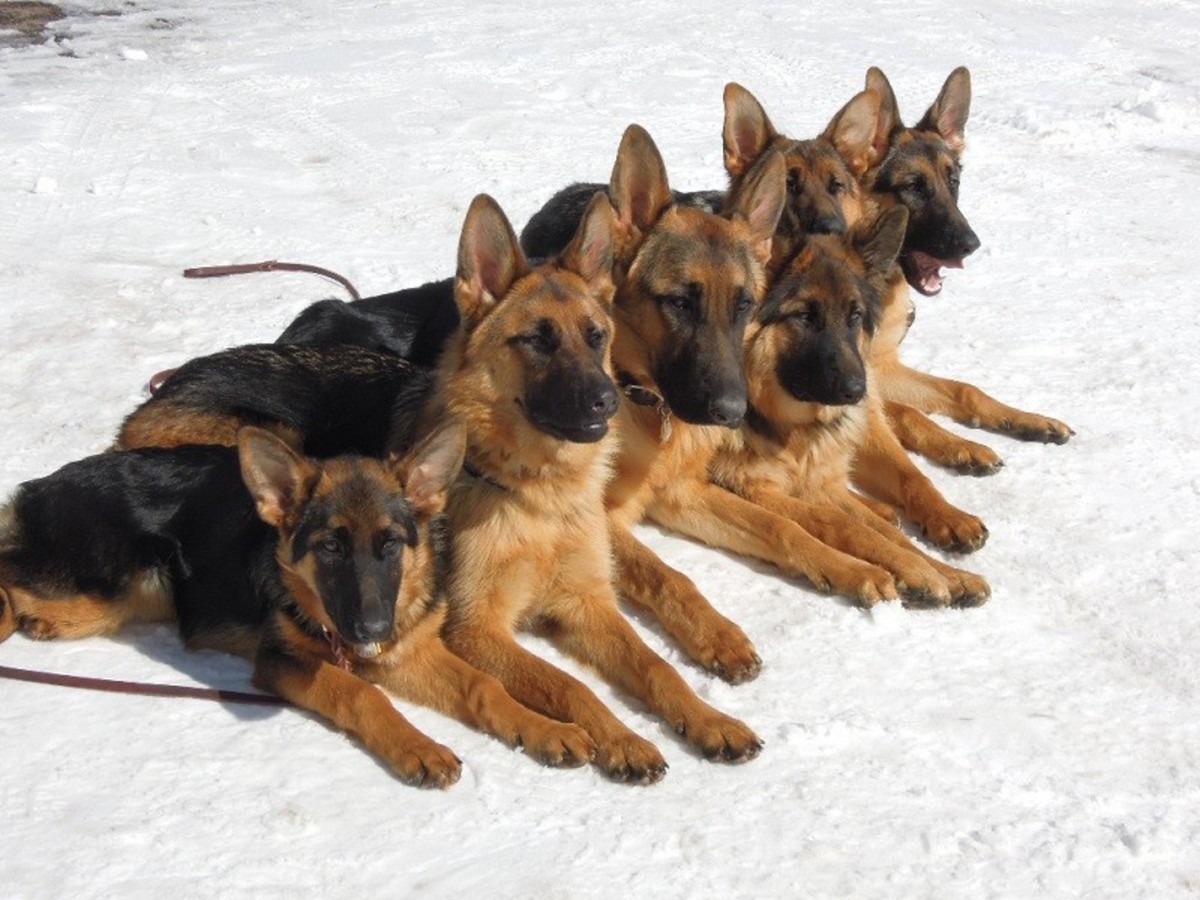My Dog Has Seizures

My dog has seizures. That's something I never expected to say. Aside from a few food allergies and UTIs, Mireille, my 2 year old Jack Russell mix, has always been a healthy and happy dog. I feed her all natural dog food. She's not a dog breed known for developing seizures. I'm overzealous about the treats she eats, toys with which she plays, not allowing her near chemicals.... I knew I was doing everything right.
Then one night my world turned upside down.

She Adopted Me
Most people adopt their dogs. Mireille adopted me. The fall of 2008 was cold. By mid-October, we had already had several hard freezes so finding a puppy on my back door step wasn't what I was expecting. She was freezing, had almost zero body fat and was severely dehydrated. She wouldn't have made it another night. Somehow she knew to come to my door, and I wouldn't let that happen.
I searched for her previous owners for several weeks but unfortunately I live in one of those areas where people dump unwanted pets and it was clear she was one of the dumped dogs. I couldn't turn her over to the Humane Society. They have a kill rate of 70-80%, and I fell in love with her at first sight. As I said, she clearly knew where to go.
The vet estimated her to be 12 weeks old and a Jack Russell Terrier/German Short Haired Pointer mix.
[This picture was taken the day we found her. She was cold and scared and starving.]
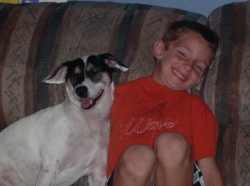
Mireille's First Seizure
Mireille was my happy-go-lucky, glass is half-full, tail wagging a mile a minute dog. She had an infectious doggie smile. She was a cuddler. She was happy....
One night Mireille and I were cuddling on the couch while watching TV. She'd been asleep for about 15 minutes when all of a sudden she started convulsing. Her eyes rolled back in her head. Her head shot back and became rigidly locked in position. She had massive amounts of foamy drool coming out of her mouth. Then her legs started running as if running a marathon.
I knew something was wrong, but I did not know what. Meanwhile my other dog and cat became curious at the commotion. Esme began barking, so I picked her put her in the bathroom as a safety precaution. I knew she would never hurt her sister, but I had no clue as to what was happening with Mireille and needed to focus on her.
Mireille stayed in her seizure for about three minutes. When she came out of it, her eyes were glassy, she was breathing hard, her back legs didn't work and she had no clue as to who I was. In an effort to get away from me, she ended up flipping backwards off the couch and dragging herself into a corner where she proceed to alternate between howling and growling at me for several minutes. Do you remember the scene in Old Yeller where they realize without a doubt the dog has rabies? The dog was scared out of it's mind, growling and backing into the corner. She was acting in much the same manner.
What should I do?
By then I'd figured out Mireille had a seizure, but I didn't know what to do. It was 10 o'clock at night. My vet was closed. I'd never been around a dog or human having grand mal seizures before and had no clue as to what to do. So I called a friend who has dogs with seizures and has experienced seizures herself.
Her advice:
Turn off the TV and radio and make the room as quiet as possible. When coming out of a seizure, one's sensory processing is messed up. Noises sound louder and more intense. Flickering from the TV can also trigger seizures in some people so might as well in pets.
Turn down the lights. Some dogs experience partial or complete blindness immediately after a seizure. Because their sensory processing isn't working correctly, any lights can feel magnified and thus painful or scary.
During the seizure, make sure the dog doesn't hurt herself by falling off the bed or chair. Move harmful objects away. Some may feel less stress when they feel physical contact from being held or soothed. However dogs coming out of grand mal seizures will not know who you are and thus may feel less stressed if you are across the room and only use soft, soothing words to speak to them.
It took 30 minutes for Mireille to recover. It felt like 30 hours. Since my friend only lives a few blocks away, she came over to help me check vital signs and make sure we didn't need to drive her to the all night veterinary hospital. Documenting vital signs also helps vets diagnose problems they did not witness.
Checklist After Seizures
- Check her capillary refill by gently pressing your thumb into her gums above the top side teeth. It should look white where you pressed but return to pink within 1 second. If it does not return to normal color within 2 seconds, this is a sign blood pressure is too low.
- Place your thumb 1/2" below her eye and gently pull down. Look at the membranes under her eye. It should be a medium pink color. A lighter pink color means low blood pressure while a blue tinge means she's not getting enough oxygen.
- Check heart rate. It is normal for heart rates to be elevated following seizures.
- Check the tongue for blood or puncture wounds as it may be bitten during the seizure.
- Check pupils to see if your dog is in shock. Both should react and be of equal size. If the pupils aren't the same size, this indicates a stroke or head/brain injury.
- Above her collar on the back side of her neck, pinch and lift the skin. It should snap back immediately. If not, she is dehydrated. Worry if takes more than 1 second to go back to normal.
- Excessive panting or sweat on the tongue or pads of her paws also indicates dehydration or being over heated. Give water and use a
cooling bandana or
cooling mat if overheated.
The First Vet Visit
I got no sleep that night. I laid down beside her, resting one hand on her side. I called my boss the moment she walked in the door and had to wait 15 more minutes to get a hold of the vet. My vet was out of the office that week and the substitute couldn't see us until 5 PM.
There's a 50% chance she'll never have another seizure.
The vet confirmed from my story that, yes, she'd had a grand mal seizure. But as it was her first confirmed one and we didn't know the trigger, he wanted to wait to do anything. He said there was a 50% chance she'd never have another seizure. But if she did start having seizures, she would start having them every few months and gradually become more frequent.
The Second Seizure
The second seizure happened only a few hours after arriving back home from the vet's office. (What happened to a few months down the road?!?)
The second seizure didn't take as long for her to pull out of. This could be for several reasons, but the length of the seizure and the length of recovery corresponds to one's environment. If I act stressed or worried, she will become stressed and worried and the seizure and recovery takes longer. If I stay calm and try to keep her calm, she is able to recover much quicker. According to my vet, it is important to keep the seizure and recovery time as short as possible. Seizures cause brain damage. The longer the seizure, the more severe the brain damage. Brain damage can cause personality changes and memory loss (including forgetting familiar people and training).
After the second seizure, I became obsessed with trying to find the cause of the seizures. I had recently switched to a new laundry detergent. The vet said it was possible ingredients in the soap could have caused them, so I rewashed every piece of clothing in the house, rewashed her bedding twice and then cleaned anything the offending laundry detergent might have touched.
I also had a full blood panel ran hoping it would come back with the cause of the seizures. It came back with no abnormalities.
Common Causes of Canine Seizures
- Toxic Chemicals Permethrin, household cleaners, insecticides.
- Genetic Disorders
- Poisoning Antifreeze.
- Epilepsy
- Tick Bites
- Food Chocolate, raisins, grapes, onions, garlic, some food colorings.
Lead Based Paint Found in older homes, old toys, old books, some dog toys made in other countries.
- Traumatic Brain Injury (TBI) or Stroke
- Environmental Factors Overheating.
- Organ Failure Seizures due to organ failure may also be linked to poisoning, genetic disorders, chemical toxins, etc.
- Brain Tumor
It Wasn't the Soap
The third seizure came a few weeks later in the dead of the night. By this time I felt we were both old hats at this. However she started exhibiting a new behavior. In her seizure journal, I wrote:
After grand mal, she "locked up" and did not move for about 1 1/2 mins with her legs in a locked tight position and head back with eyes glassy and unblinking.
Again after she came out of the seizure, she had no clue who I was yet and showed signs of fear. Every five or so minutes, I would give her a known command to try to judge her mental status. It took 90 minutes for her to recognize her own name. Fatigue quickly set in that lasted three days.
Emergency Room
If your dog has a seizure lasting more than 5 minutes, take her to the veterinary emergency room immediately!
Then They Didn't Stop
Mireille had precisely nineteen days of peace. Then they wouldn't stop.
Mireille was acting normal when I came home. The first seizure came around 7. She was able to pull out of it quickly and recovery lasted only a few minutes. The second came an hour later and the third around 10. I called my vet at home and she said we had to get to the emergency room immediately.
Upon arrival at the emergency room, the emergency room vet saw signs another seizure was eminent and took her away from me. Luckily a friend drove us to the emergency room in case Mireille had a seizure in the car, and she waited with me. It felt like an hour before a resident came out to get Mireille's medical history and give us an update. Then we waited another hour without knowing anything. The doctor's diagnosis: Mireille was having seizures, we don't know why and she needs to stay in ICU and be transferred to neurology the next morning to run an MRI and CAT scan. Having previously spoken with my vet and done research myself, I knew there was only a 5% chance the MRI and CAT scan would be able to tell us anything. I chose to keep her in ICU and transfer to my vet's care the next morning.
Should something happen, do you want us to save her?
Before I left I had to sign papers of whether or not I wanted a Do Not Resuscitate order on her should anything happen. They couldn't even give me reassurance she would still be alive when I came to pick her up the next day.
When I got home, I found evidence Mireille had had at least 3 additional seizures sometime in the previous 36 hours. (Total of at least six.)
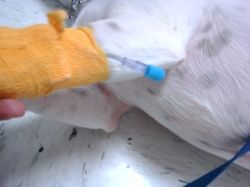
Catheter
Because Mireille had suffered so many seizures in such a short amount of time, the emergency room veterinarian worried she might start having cluster seizures. Cluster seizures can cause death in dogs, so they inserted a catheter into her front leg. This would allow them to administer anti-seizure medications directly into her bloodstream if needed.
She made it through the night without another seizure, but due to other animal emergencies the emergency room was unable to release her until almost 10 the next morning. Two friends work at the hospital and came to sit with while I waited. I was grateful for their help as both have also had dogs with seizures and knew additional questions to ask the emergency room vet before Mireille was released.
When I finally was able to see Mireille again, she still had the catheter. They decided to leave it in just in case she started having grand mals while we were at our vet's office.
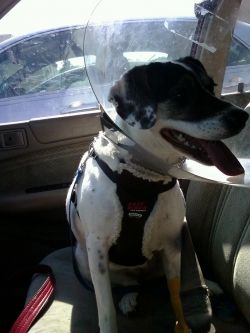
Vet's Office
Mireille was acting spacey at the hospital, but the attending didn't appear to worry about it. I signed her out, got her buckled into the car and was chuckling at the silly image of her in an e-collar. She normally hams it up for the camera but I couldn't get her to look at me. It should have been a clue. She had a partial seizure a few minutes later. I am so thankful she was buckled in her safety harness as she would have been injured should she have fallen during the drive.
Our general vet examined Mireille and released her back into my custody with special instructions. She was not to be left alone for more than a few minutes for the next two days, and she had to start taking anti-seizure medication that would cause side effects including personality changes and fatigue for 7 to 10 days.
The side effects lasted longer than expected. She didn't recognize people she's known since she was a puppy. She didn't know her own name or ingrained commands. It took almost three weeks for her tail to wag again, and it still doesn't wag as much as it used to wag. She had extreme fatigue. She gained 4 lbs. She was constantly hungry and thirsty. Something was wrong.
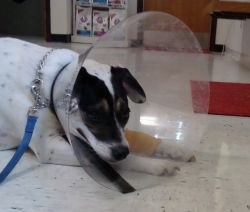
Anti-seizure medication causes liver damage in 20% of all dogs. Signs include a yellowing of the eye membranes and belly skin, fatigue, appetite change, thirst, weight change, behavioral changes, etc. Another blood test revealed phenobarbital levels in her liver were high even though she was on the lowest level allowed. This meant her dog food and the phenobarbital were working against each other. She's now on a prescription diet specifically designed for dogs with liver problems.
Common Treatments for Dog Seizures
- Medication
- Surgery
- Dietary Changes
- Wait and See
The Ice Pack Remedy
Have you ever heard people tell you to put an ice pack on a dog's lower back while they're seizing? This helps in a few ways.
Pet Insurance
Any trip to the vet is expensive, but throw in a trip to the emergency room, blood work and medications and you could be looking at hundreds (if not thousands) of dollars. When dealing with seizures, an initial consult with your primary veterinarian will cost about $30-60. They may then refer you to a dog neurologist. Mireille's initial blood work was $120, but she is now on an anti-seizure medication ($8/month) that will require more blood work ($200) at 45 days and then at different intervals thereafter. For some dogs, they may recommend CAT scans or MRIs ($500-1000) to rule out brain tumors, abnormal skulls or other problems.
Does your dog or cat have pet insurance?
Thundershirts
Being a terrier, Mireille's always been a little high strung, but my vet and the veterinary hospital both warned me any stress could trigger more seizures, so I bought Mireille a Thundershirt. Thundershirts work similar to the ways swaddling calms babies and weighted blankets calm children with autism. A light, constant pressure on the torso helps keep dogs calm and less stressed.
Have you used Thundershirts before?
Mireille Wearing Her Thundershirt

Or a dog with special needs? Do you have advice for other pet parents going through this? Please share. You do not need to be register with Squidoo to comment.



